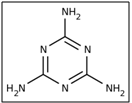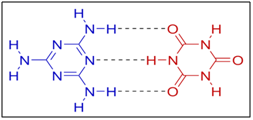WHAT IS MELAMINE?
Melamine (1,3,5-triazine-2,4,6-triamine) is a nitrogen-rich organic compound (66% w/w nitrogen content), which is used as the starting material for the manufacture of synthetic resins. It is present in the form of a white-coloured crystalline powder. [1]
Synthesis of melamine - Melamine is synthesized from urea, at a temperature of 350-400oC, under -
→ High Pressure liquid phase (90-150 bar pressure), or
→ Low Pressure gaseous phase (1-10 bar pressure)

After synthesis, melamine undergoes dehydration, which results in the formation of a white-coloured crystalline solid powder - this is the solid form of melamine.
Synthesis of melamine from urea also yields intermediate by-products such as biuret, cyanuric acid, ammeline, ammelide, etc. [2]
Properties of melamine

MELAMINE [3]
- The molecular formula of melamine is C3H6N6.
→ Melamine is a metabolic by-product of the pesticide Cryomazine.
- The molecular weight of melamine is 126.12 g/mol.
- The melting point of melamine is 345-347oC, and decomposes upon melting.
- The dissociation constant (pKa) is 5.35 at 25oC. [2] [4]
BASIS FOR MELAMINE TOXICITY
Melamine has high nitrogen content, due to which it is used as a protein substitute in many food products. However, the use of melamine has not been approved by the FDA or the WHO. Melamine is also used for making plastics.
By itself, melamine is a non-toxic substance in low doses. Cyanuric acid is a by-product formed during the synthesis of melamine. Therefore, when melamine combines with cyanuric acid in the ratio of 1:1, melamine cyanurate is formed. [5]

MELAMINE CYANURATE
Melamine cyanurate is the main cause for the toxicity of melamine.
When melamine cyanurate is ingested through food or through contaminated plastic utensils, it is circulated throughout the body. Melamine cyanurate cannot be broken down by any cellular enzymes. Therefore, it remains static and unmetabolized inside the body. However, the body attempts to flush out this toxic compound through the kidneys. Therefore, melamine cyanurate keeps getting accumulated in the kidneys to a large extent, and forms crystallized stones. But, these stones cannot be flushed out, and they damage renal cells, leading to kidney malfunction. [6]
Melamine is also suspected have a negative effect on the functioning of the reproductive system as it possesses the ability to act as a reproductive toxicant. [7]
Analytical tests for detecting the presence of melamine cyanurate in food
Some of the analytical tests used for detecting the presence of the toxic substance melamine cyanurate in foods are as follows - [8] [9]
→ Gas Chromatography - Mass Spectrometry (GC-MS)
- Solid Phase Extraction Liquid Chromatography - Mass Spectrometry
(SPE / LC-MS)
→ High Performance Liquid Chromatography (HPLC)
→ Hydrophilic Interaction Liquid Chromatography (HILIC)
→ Triple Quadrupole Liquid Chromatography (TQLC)
→ Electrospray Ionization coupled with Mass Spectrometry (ESI-MS)
→ High Performance Liquid Chromatography - Electrospray Ionization - Tandem Mass Spectroscopy (HPLC - ESI - MS/MS)
→ Ultrasound-Assisted Extractive Electrospray Ionization Mass Spectrometry
(ESSI-MS)
→ Surface Enhanced Raman Spectroscopy (SERS)
→ High Performance Liquid Chromatography - Tandem Mass Spectroscopy
(HPLC-MS/MS)
- Tandem Mass Spectroscopy (MS/MS)
- Single-Stage Mass Spectrometry (MS)
- Diode Array Detection (DAD)
- Ultraviolet Absorption (UV)
→ Enzyme Linked Immuno Sorbent Assay (ELISA)
→ "Direct analysis in real time" ion source coupled to Time-of-Flight Mass Spectroscopy (TOFMS)
- Chemiluminescence
→ High Performance Liquid Chromatography - Time-of-Flight Mass Spectroscopy (HPLC-TOFMS)
→ Fourier Transform Infrared (FTIR) microscopy
→ Proficiency Test in a milk matrix used for testing infant milk formula
SYMPTOMS AND EFFECTS OF MELAMINE TOXICITY [10] [11]
| Symptoms | Effects |
| Presence of blood in urine | Nephrolithiasis (kidney stones) with melamine crystalluria |
| Nausea and vomiting | Urinary tract infections |
| Infrequent urination | Kidney inflammation |
| Backache | Kidney damage |
| High blood pressure | Urinary bladder carcinoma |
| Crying in children while passing urine | Elevation in Blood Urea Nitrogen (BUN) and creatinine levels |
| Proteinuria | Nephrosis (degeneration of renal tubules) |
| Decrease in levels of free-radical scavenging enzymes | Haemorrhagic cystitis |
| Altered sexual behaviour | Female Infertility |
| Altered onset of puberty | Lactation problems |
| Altered onset of menopause | Menstrual and pregnancy problems |
| Altered sperm count | Male infertility |
| Low sperm motility | |
| Altered change in shape of sperm |
CASES OF MELAMINE TOXICITY
Ø Milk poisoning in China - In 2008, infant milk formula and other baby food was found to be contaminated with melamine and its products. It was estimated that around 300,000 infants fell victim to melamine poisoning. Melamine had been added as a protein substitute to infant milk formula, owing to its high nitrogen content. 16 infants were diagnosed with kidney stones, owing to consumption of melamine.
These stones were analyzed using techniques such as infrared spectroscopy, nuclear magnetic resonance, and high performance liquid chromatography. It was found that these kidney stones contained a mixture of melamine and uric acid present in the ratio 2:1. [12]
Ø Pet food recall - Various brands of pet foods were recalled in 2007 after it was reported that pets suffered from renal failure. Pet food containing corn gluten was also found to be contaminated with melamine. Various veterinary organizations reported more than 100 pet deaths and almost 500 cases of kidney failure.
The symptoms of melamine toxicity observed in pets -
♦ Kidney failure
♦ Loss of appetite
♦ Lethargy
♦ Depression
♦ Dehydration
♦ Changes in water consumption and urinary habits [13]
MELAMINE TOXICOLOGY RESEARCH STUDIES
- Gut bacteria play a role in inducing renal toxicity of melamine - Infant formula which contains only melamine but does not contain cyanuric acid has been found to cause kidney stones. Research scientists from the University of North Carolina observed that the metabolites produced by intestinal (gut) bacteria upon exposure to melamine are different as compared to those produced when not exposed to melamine.
In the test group, rats were given a dosage of antibiotics for four days (so as to eliminate gut bacteria), followed by a two-week dosage of melamine. In the control group, rats were administered melamine without antibiotics.
Rats on antibiotics were found to suffer less renal damage as compared to those rats which were not administered antibiotics. It was also observed that rats on antibiotics excreted two times more melamine as compared to those rats which were not administered antibiotics. This could be put down to elimination of gut bacteria by the antibiotics due to which melamine was not converted to its toxic form. [14]
It can thus be concluded that gut bacteria play a role in the renal toxicity of melamine in the absence of cyanuric acid.
- Honey extracted from honeybee comb displays protective effects against melamine toxicity - Honey produced by honeybees has been found to display protective effect against melamine toxicity in the liver of male rats.
Melamine was supplied to male rats at a dosage of 20000 ppm for a period of 28 days. Consumption of melamine induced adverse effects such as altered hepatic enzyme activity and necrosis in hepatic tissue due to crystallization of melamine.
The rats which were affected by melamine toxicity were then subjected to treatment with naturally-produced honey produced by honeybees at a dosage of 2.5g/kg of body weight for a period of 28 days. It was observed that consumption of honey improved the functioning of the liver, as well as improved hepatic enzyme activity. [15]
- Melamine can induce toxic effects on central nervous system - The most critical periods of brain development in a human being are the foetal development stage and infancy. Research shows that melamine possesses the ability to pass through the blood brain barrier and display neurotoxic effects on the central nervous system. [16]
- Melamine and cyanuric acid exhibit toxicity in fish (Clarius batrachus) - Walking catfish (Clarius batrachus) were exposed to melamine and cyanuric acid, separately as well as in combined form.
After three days of feeding, melamine and cyanuric acid started showing the following toxic effects -
♦ Darkening of skin
♦ Distribution of melamine crystals in lungs, kidney, heart, spleen, etc.
♦ Elevations in serum concentrations of enzymes such as alanine transaminase and aspartate transaminase
♦ Rise in levels of nitrogenous compounds such as creatinine and uric acid
♦ Renal damage [17]
- Melamine exhibits carcinogenic effects in mice and rats - Melamine was administered in the diets of mice and rats for a period of 13 weeks to study its toxicological effects. The dosage level of melamine administered was 750 to 18000 ppm for rats, and 6000 to 18000 ppm for mice.
The following adverse carcinogenic effects were observed -
♦ Melamine-related lesions
♦ Development of uroliths (urinary bladder stones)
♦ Hyperplasia (increase in cell proliferation) of urinary bladder epithelium
♦ Urinary bladder cell carcinoma
♦ Inflammation of kidney and urinary bladder
♦ Ulceration of bladder epithelium [18]
However, greater research needs to be carried out in greater detail to understand if these carcinogenic effects can develop into full-fledged malignancy.
TREATMENTS FOR MELAMINE TOXICITY
Treatments for kidney damage caused by melamine toxicity - [19]
→ Intravenous fluids and dialysis to remove melamine from kidneys
→ Fluid intake should be carefully monitored
- Surgical removal of kidney stones
→ Medication for controlling blood pressure, nausea, anemia
→ Kidney function tests for monitoring progression of treatment
- Alkalinization of urine
Treatments for reproductive damage caused due to melamine toxicity - [20]
→ Avoidance of teratogenic agents which can affect the growth and development of the foetus
→ Banning of medications which can affect reproductive health
REFERENCES -
[1] http://jasn.asnjournals.org/content/20/2/245.full
[2] http://www.who.int/foodsafety/fs_management/Melamine_2.pdf
[3] https://upload.wikimedia.org/wikipedia/commons/0/05/Melamine.svg
[4] http://wiki.answers.com/Q/What_are_the_properties_of_melamine
[5] http://en.wikipedia.org/wiki/Melamine_cyanurate
[6] http://voices.yahoo.com/what-causes-melamine-poisoning-7603868.html
[7] http://www.rightdiagnosis.com/r/reproductive_toxicity_melamine/intro.htm#whatis
[8] http://en.wikipedia.org/wiki/Melamine#Testing_in_food
[9] http://food.eurofins.com/melamine.aspx
[10] http://www.poisons.co.nz/fact.php?f=43
[11] http://www.rightdiagnosis.com/r/reproductive_toxicity_melamine/intro.htm
[12] http://en.wikipedia.org/wiki/2008_Chinese_milk_scandal
[13] http://en.wikipedia.org/wiki/2007_pet_food_recalls
[14] http://news.sciencemag.org/2013/02/gut-bacteria-conspired-melamine-poisonings
[15] http://www.hindawi.com/journals/bmri/2013/786051/
[16] http://tih.sagepub.com/content/28/7/579.abstract
[17] http://www.ncbi.nlm.nih.gov/pubmed/22316434
[18] http://www.ncbi.nlm.nih.gov/pubmed/6695376
[19] http://www.medindia.net/patients/patientinfo/kidney-failure-due-to-melamine-toxicity.htm
[20] http://www.rightdiagnosis.com/r/reproductive_toxicity_melamine/treatments.htm
About Author / Additional Info: